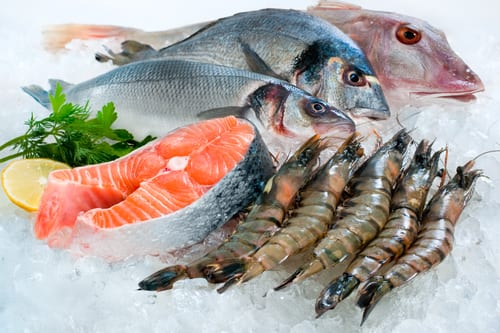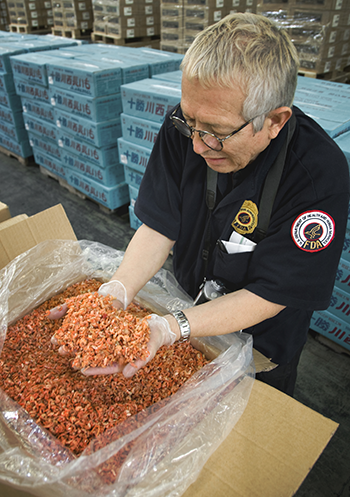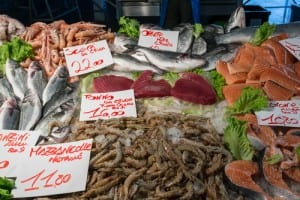
Everett Griner talks about looking for “U.S. Farm-Raised” on our products in today’s Agri View.
Farm-Raised
From: FDA.gov
How FDA Regulates Seafood: FDA Detains Imports of Farm-Raised Chinese Seafood
On June 28, 2007, FDA announced a broader import control of farm-raised catfish, basa, shrimp, dace (related to carp), and eel from China. FDA will start to detain these products at the border until the shipments are proven to be free of residues from drugs that are not approved in the United States for use in farm-raised aquatic animals. The agency took this action to protect American consumers from unsafe residues detected in these products. There have been no reports of illnesses to date.
 FDA is taking this strong step now because of continuing evidence that certain Chinese aquaculture products imported into the United States contain illegal substances. Aquaculture, also known as fish farming, involves raising fish in enclosed areas to be sold for food. Almost half of all imported seafood is from aquaculture, according to the U.S. Department of Commerce.
FDA is taking this strong step now because of continuing evidence that certain Chinese aquaculture products imported into the United States contain illegal substances. Aquaculture, also known as fish farming, involves raising fish in enclosed areas to be sold for food. Almost half of all imported seafood is from aquaculture, according to the U.S. Department of Commerce.
During targeted sampling, from October 2006 through May 2007, FDA repeatedly found that farm-raised seafood from China was contaminated with antimicrobial agents that are not approved for use in the United States. More specifically, the antimicrobials nitrofuran, malachite green, gentian violet, and flouroquinolones, were detected. Nitrofurans, malachite green, and gentian violet have been shown to cause cancer with long-term exposure in lab animals. The use of fluoroquinolones in food animals may increase antibiotic resistance, making it harder for this class of drugs to fight certain infections in people.
“Consumers should know that this is not an immediate public health hazard,” says Robert Brackett, PhD, director of FDA’s Center for Food Safety and Applied Nutrition. “The levels of contaminants that have been found are very low, and FDA is not advising consumers to destroy or return farm-raised seafood that they may have already purchased and have in their homes. The agency also is not seeking a recall of products already in the marketplace.”
FDA is taking this action as a precautionary measure to prevent problems that may occur from long-term exposure to harmful residues. The agency is also concerned about the possible development of antibiotic resistance. “This action serves to keep contaminated products from entering the country so that they don’t reach American consumers,” Brackett says.
Here’s a look at how FDA works to protect consumers from unsafe seafood.
From: Seafood.EDF.org
Buying fish? What you need to know
Buying eco-friendly fish is easier when you know where it’s from and how it was caught or farmed. Our Seafood selector does a lot of the work for you, synthesizing and simplifying the research. But when you’re at the fish counter or restaurant, knowing what questions to ask is key. And remember, an informed consumer requesting eco-friendly fish sends a powerful conservation message.
Educating Yourself on Sustainable Fishing Practices
 There is no universal seafood labeling system for grocery stores, restaurants, or fish markets, so buying eco-friendly fish often requires a little diligence on your part.
There is no universal seafood labeling system for grocery stores, restaurants, or fish markets, so buying eco-friendly fish often requires a little diligence on your part.
Your restaurateur or fishmonger may not have all the answers, but the more questions you ask, the more they will recognize the need to provide better information to their customers. Here are the best things to ask, especially if labels do not provide enough information:
- What country is it from?
- Is the fish wild-caught or farm-raised?
- If it is farmed, how was it grown? (Was it raised in a polluting open net pen or in a contained tank or pond?)
- If it is wild, how was it caught? (Were long lines used, or was it caught by pole? Long lines often catch extra unwanted “bycatch.”)
- Are populations of this fish healthy and abundant? (Small, fast-growing fish can withstand more fishing pressure, while large, slow-growing species are more vulnerable to overfishing.)
- Are there eco-friendly alternatives?
- Is this fish really a… (red snapper, wild salmon, grouper, etc.)? These are prime candidates for fish fraud.
Fish Fraud: Are You Getting What You Think You’re Getting?
The U.S. Food Drug and Drug Administration, which oversees the safety of our seafood supply, defines fraud as the substitution of a less expensive fish for a more expensive kind; for example, tilapia for red snapper, farmed salmon for wild, or basa or tra (Vietnamese catfish) for grouper.
In perhaps the most well-known case of fish mislabeling, The New York Times showed that fish sold as wild salmon by high-end New York City markets was mostly farm-raised, selling for as much as $29 a pound.
Unfortunately, it wasn’t an isolated incident. Recently there have been numerous reports of fraud occurring in restaurants, supermarkets and with suppliers, both in the U.S. and abroad. Being informed and knowing your seafood is the best way to arm yourself against fraud. Some things that should raise red flags are:
- A price too good to be true for a highly desired fish like red snapper or grouper.
- Out-of-season fish, like wild salmon from Alaska, being sold “fresh” in winter months.
- Wacky labels you know not to be true, such as “farmed Chilean seabass” (only caught in the wild) or “wild Atlantic salmon” (an endangered species and not commercially available).
If you think you’re being served a less desirable substitute or a mislabeled fish, press the chef or fish seller for answers.
Making Fish Substitutions
There are a variety of fish species with similar flavors and textures, so there is no need to choose an Eco-Worst fish when you can substitute an Eco-Best. For example, you can substitute:
- farmed striped bass or U.S. catfish for orange roughy and Chilean seabass;
- wild Alaskan salmon, farmed Arctic char or rainbow trout for farmed salmon (Atlantic salmon in U.S. stores and restaurants is always farmed);
- pole-caught tuna instead of longline or purse seine-caught tuna; or
- U.S. shrimp for imported shrimp.
Country-Of-Origin Labeling
Of some help to consumers is country-of-origin labeling (also known as C.O.O.L.). In place since 2005, this labeling requires that large retailers (such as supermarkets) selling fresh or frozen fish indicate the country the fish came from and whether it is wild-caught or farm-raised.
Restaurants and small fish markets are exempt, but may label voluntarily and should still be able to give you this information. Processed or altered fish (such as canned or smoked fish, breaded shrimp and imitation crab meat) is also exempt.
What is Certification of Seafood?
Certification is a process for assuring that fisheries or fish farms have met certain environmental criteria. The best certification systems use a third-party auditor to determine compliance with their standards.
The most well-known example of seafood certification is probably the “dolphin-safe tuna” label created in the 1990s, prompted by demand for tuna caught without injuring or killing dolphins in the process. The label grew out of amendments to the Marine Mammal Protection Act to conserve marine mammals like dolphins, seals and whales.
While eco-labels for seafood are more prevalent in Europe than the U.S., here are the main ones to watch for:
Eco-Labels for Wild Fish
Marine Stewardship Council (MSC). With its blue fish and check logo, the MSC is the largest and most globally recognized eco-label for wild-caught seafood. Its standards meet the United Nations’ eco-labeling guidelines, and to date, the MSC has certified almost 200 fisheries (with a similar amount undergoing assessment). To obtain the MSC seal of approval, a fishery must demonstrate effective management, and maintain healthy populations and ecosystems.
Eco-Labels for Farmed Fish
Fish farming has boomed in recent decades, and today half of all seafood is farm-raised, not wild-caught. This robust growth, coupled with growing concern over environmental and health issues, has fueled interest in organic aquaculture.
Organic labeling: Buyer Beware. Some fish sold in the U.S. are labeled “organic”, but this might not mean what you think. The U.S. Department of Agriculture (USDA) has yet to finalize organic standards for farmed fish**, but “organic” salmon, shrimp, cod and tilapia from abroad are still available.
While these certifications provide some advantages over conventional farmed fish, they do not necessarily translate into environmental sustainability. For example:
- Most foreign organic standards allow the use of open net pens that can pollute surrounding waters.
- Several certifiers permit use of chemicals to control parasites.
- Some allow nonorganic seafood byproducts, which may have significant levels of contaminants, in fish feed.
California currently prohibits sales of “organically” labeled fish until U.S. standards are in place. The bottom line: Before you buy an eco-labeled fish, do your homework, read labels carefully and ask your fish seller lots of questions.









